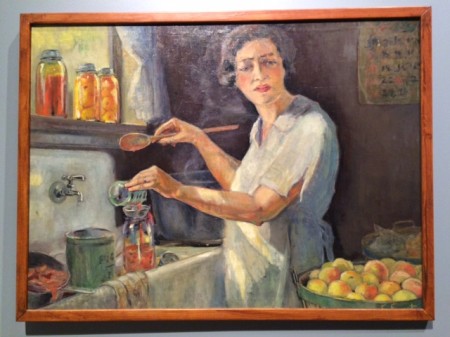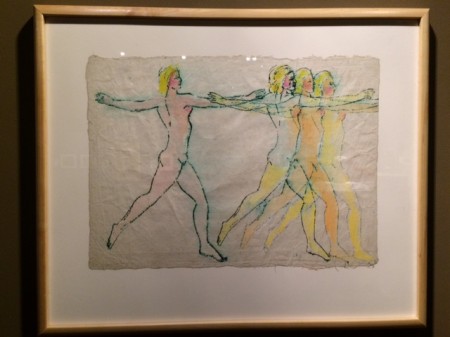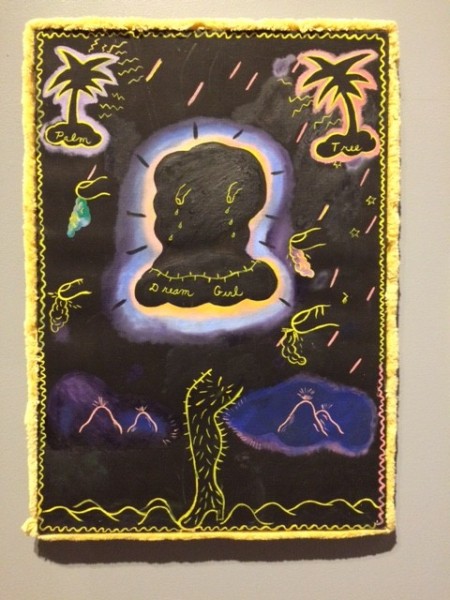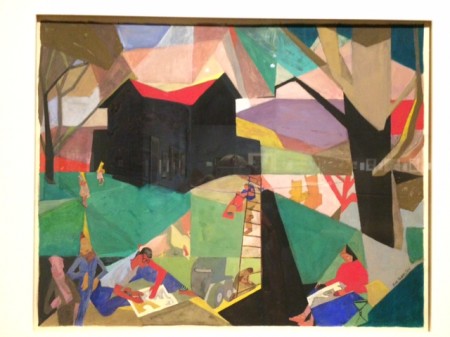Making Their Mark: Illinois Women Artists, 1940-1960 opened October 17 and is on view until January 17, 2016 at the International Features Gallery of the Peoria Riverfront Museum in Peoria, Illinois. With this exhibition, the museum is contributing to the necessary scholarship on women artists.
This rich and diverse exhibition of over seventy art works is both an art exhibition featuring works seldom seen, and a glimpse into recent American history, with such themes as frugality after post-Depression America readied for sacrifice during World War II. Florence Furst’s oil painting Home Defense, one of the oldest paintings in the show, features a woman canning peaches in a homey 40’s kitchen bathed in optimistic light. Women artists did not fail to overlook what was everyday activity in the face of sacrifice. Numerous immigrant women who came to the Midwest and later became artists are in the show, including Gerda Meyer Bernstein, one of the last survivors of the kinder transport out of Germany.
Chicago, being the largest immigrant city in Illinois, has numerous artists in this exhibit, such as Polish-born Polia Pillin and British-born Juliet Kepes, wife of György Kepes, (Hungarian-born painter, photographer, designer, educator, and art theorist who taught design at Illinois Institute of Design or IIT in Chicago and later at MIT.) Juliet should not be eclipsed by her famous husband and exhibitions like this help to make visible the art work and research of women artists like her. Featured in this exhibition are two of her intimate, amorphic abstract watercolors revealing her search for new forms using modernist language. Juliet’s paintings, drawings and sculptures were exhibited at the Art Institute of Chicago, Baltimore Museum and Worcester Museum. Juliet wrote and illustrated children’s books, like the innovative Five Little Monkeys, which won a prestigious Caldecott Medal for illustration in 1953. Groundbreaking was her use of expressive, calligraphic brushwork, vibrant color and overall design qualities, not seen before in children’s books. Three of her books were nominated amongst the New York Times’ Ten Best Children’s Books of the Year.
Channy Lyons, Director of the Illinois Women Artists Project (IWA) and local historian, serves as the exhibit’s guest curator. The exhibition, in the press materials, “examines the role of female artists in defining the artistic styles developed between 1940 and 1960, how they built on the legacy of women artists who preceded them, as well as the ways that they influenced the women artists who succeeded them. It focuses on the impact of female artists active in Illinois between the government-sponsored art programs of the 1930s – including the Federal Art Project of the WPA – and the emergence of the Chicago Imagists, nationally recognized as the artists who “put Chicago on the art map” in the mid-1960s.”
Perhaps the most famous artist in the show is Nancy Spero, beloved of feminists and collectors of political art. Francois Pinault, the famous European billionaire collector has Spero’s work prominently installed in his second site in Venice, Italy. No stranger to curators, Nancy was in the 2007 Venice Biennale with a Maypole in the entrance to the grand Italian Pavilion that featured rather macabre paper and ink heads of state, just their heads, hung from colored ribbons gently moving in the breeze. In this exhibit, she is featured with a signature piece, a spare watercolor of women in profile, running.
Spero was among the artists the Riverfront’s curator Kristan McKinzie placed in a section called “Instructors and Mentors.” These women artists wore numerous hats: artist, wife, mother, educator. All of them were influential as educators, activists and founders of collectives. These Chicago-based women include Vera Berdich, who headed the etching department at the School of the Art Institute of Chicago, Kathleen Blackshear, June Leaf, Irene Siegel, Suellen Rocca, Vera Klement and Ellen Lanyon. These organizational activities were very important to women artists to ensure they had a voice that competed with the boys’ club. Some of the artists still make their mark today. Spero and Lanyon were highly active in the feminist movement of the 1960’s and Lanyon founded ARC Gallery that is still in existence. This is a laudable legacy indeed.
Whether in a major city like Chicago or in other cities like Peoria or Carbondale, these women did not face the same pressures to produce a certain kind of saleable artwork popular in New York with critics and galleries. Thus, they could explore more personal idioms. It is no wonder the Chicago Imagists artists formed in this open and unconstrained environment. Just like Judith Leyster* was written out of the history books as one of the members of the same artists’ guild as Rembrandt, so these women were active artists and agents of change whose name, and more importantly, art work should be viewed and exhibited on par with their male contemporaries.
The exhibition opening coincides with the IWA’s third bi-annual symposium, Midwest Women Artists 1940-1960: Discovering Their Work, Telling Their Stories, Learning from the Past held October 22-23, 2015 at Bradley University. Dr. Robert Cozzolino, Senior Curator at the Pennsylvania Academy of Fine Art was the keynote speaker.
Peoria Riverfront Museum, 222 SW Washington St, Peoria, IL 61602
(309) 686-7000 10:00 AM – 5:00 PM
*http://aeqai.com/main/2014/01/letter-from-chicago-focus-on-five-artists-and-a-nod-to-leyster/
Letter from Chicago: Focus on Five Artists and a Nod to Leyster
Cynthia Kukla is an artist and critic living in Illinois.
All photographs by author










